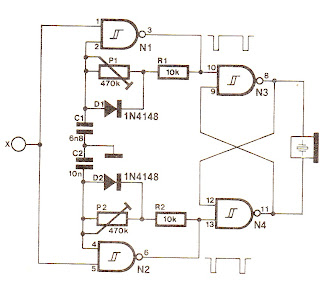The former are driven by an AF signal source, while the latter feature a built-in oscillator, and require a direct voltage only. This circuit is a double AF oscillator for driving passive buzzers. It ensures a richer out- put sound than normally obtain- able from a piezo buzzer due to the use of two oscillators, N1 and N2, whose output signal lies between 1 and 10 kHz. Gates Na-N4 form an S-R bistable which is controlled by the out- puts of N1-N2, and drives the buzzer direct.
Optimum effects are achieved when a simple ratio is set between the oscillator frequencies, e.g. 3:4.
Piezoelectric resonators, also referred to as buzzers, are frequently used for providing audible signals in all sorts of electronic equipment.
The spectral l composition of the output X signal is fairly complex, due to the presence of both the fun- damental notes and the differ- ence and sum frequency.
The timbre so obtained varies as a function of the ratio between the oscillator frequencies, which are adjustable with the aid of presets P1-P2. Note that diodes D1-D2 reduce the duty factor of the oscillator signals to about 25%.
The resulting waveform is always composed of rectangular signals, but these differ in respect of their period to ensure that the buzzer pro- duces a rather agreeable sound. The buzzer driver is controlled by a logic level applied to point X. The quiescent current consumption is virtually negligible, while about 10 mA is drawn in the actuated state.
Buzzer Driver Circuit Diagram












No comments:
Post a Comment